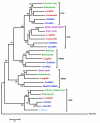Visual pigments in a living fossil, the Australian lungfish Neoceratodus forsteri
- PMID: 17961206
- PMCID: PMC2194722
- DOI: 10.1186/1471-2148-7-200
Visual pigments in a living fossil, the Australian lungfish Neoceratodus forsteri
Abstract
Background: One of the greatest challenges facing the early land vertebrates was the need to effectively interpret a terrestrial environment. Interpretation was based on ocular adaptations evolved for an aquatic environment millions of years earlier. The Australian lungfish Neoceratodus forsteri is thought to be the closest living relative to the first terrestrial vertebrate, and yet nothing is known about the visual pigments present in lungfish or the early tetrapods.
Results: Here we identify and characterise five visual pigments (rh1, rh2, lws, sws1 and sws2) expressed in the retina of N. forsteri. Phylogenetic analysis of the molecular evolution of lungfish and other vertebrate visual pigment genes indicates a closer relationship between lungfish and amphibian pigments than to pigments in teleost fishes. However, the relationship between lungfish, the coelacanth and tetrapods could not be absolutely determined from opsin phylogeny, supporting an unresolved trichotomy between the three groups.
Conclusion: The presence of four cone pigments in Australian lungfish suggests that the earliest tetrapods would have had a colorful view of their terrestrial environment.
Figures




Similar articles
-
Visual ecology of the Australian lungfish (Neoceratodus forsteri).BMC Ecol. 2008 Dec 18;8:21. doi: 10.1186/1472-6785-8-21. BMC Ecol. 2008. PMID: 19091135 Free PMC article.
-
Early evolution of vertebrate photoreception: lessons from lampreys and lungfishes.Integr Zool. 2009 Mar;4(1):87-98. doi: 10.1111/j.1749-4877.2008.00138.x. Integr Zool. 2009. PMID: 21392279 Review.
-
Complete mitochondrial genome sequences of the South american and the Australian lungfish: testing of the phylogenetic performance of mitochondrial data sets for phylogenetic problems in tetrapod relationships.J Mol Evol. 2004 Dec;59(6):834-48. doi: 10.1007/s00239-004-0122-8. J Mol Evol. 2004. PMID: 15599515
-
Molecules, fossils, and the origin of tetrapods.J Mol Evol. 1992 Aug;35(2):102-13. doi: 10.1007/BF00183221. J Mol Evol. 1992. PMID: 1501250 Review.
-
Lungfish albumin is more similar to tetrapod than to teleost albumins: purification and characterisation of albumin from the Australian lungfish, Neoceratodus forsteri.Comp Biochem Physiol B Biochem Mol Biol. 2007 Jul;147(3):428-37. doi: 10.1016/j.cbpb.2007.02.009. Epub 2007 Mar 3. Comp Biochem Physiol B Biochem Mol Biol. 2007. PMID: 17409005
Cited by
-
Evolution of Vertebrate Phototransduction: Cascade Activation.Mol Biol Evol. 2016 Aug;33(8):2064-87. doi: 10.1093/molbev/msw095. Epub 2016 May 11. Mol Biol Evol. 2016. PMID: 27189541 Free PMC article.
-
Nonlethal age estimation of three threatened fish species using DNA methylation: Australian lungfish, Murray cod and Mary River cod.Mol Ecol Resour. 2021 Oct;21(7):2324-2332. doi: 10.1111/1755-0998.13440. Epub 2021 Jun 23. Mol Ecol Resour. 2021. Retraction in: Mol Ecol Resour. 2025 Jul 21:e70018. doi: 10.1111/1755-0998.70018. PMID: 34161658 Free PMC article. Retracted.
-
The evolution of early vertebrate photoreceptors.Philos Trans R Soc Lond B Biol Sci. 2009 Oct 12;364(1531):2925-40. doi: 10.1098/rstb.2009.0099. Philos Trans R Soc Lond B Biol Sci. 2009. PMID: 19720654 Free PMC article. Review.
-
Visual ecology of the Australian lungfish (Neoceratodus forsteri).BMC Ecol. 2008 Dec 18;8:21. doi: 10.1186/1472-6785-8-21. BMC Ecol. 2008. PMID: 19091135 Free PMC article.
-
Short-wavelength-sensitive 2 (Sws2) visual photopigment models combined with atomistic molecular simulations to predict spectral peaks of absorbance.PLoS Comput Biol. 2020 Oct 21;16(10):e1008212. doi: 10.1371/journal.pcbi.1008212. eCollection 2020 Oct. PLoS Comput Biol. 2020. PMID: 33085657 Free PMC article.
References
-
- Yokoyama S, Yokoyama R. Adaptive evolution of photoreceptors and visual pigments in vertebrates. Annu Rev Ecol Syst. 1996;27:543–567. doi: 10.1146/annurev.ecolsys.27.1.543. - DOI
Publication types
MeSH terms
Substances
LinkOut - more resources
Full Text Sources
Miscellaneous

